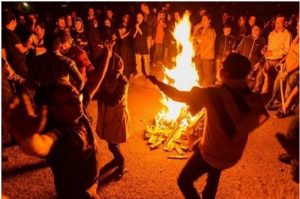 A civil struggle for beauty, happiness, and enlightenment
A civil struggle for beauty, happiness, and enlightenment
The simple definition of “civil disobedience” is to protest or engage in a nonviolent struggle against an order, method, or policy imposed by a power or government on the people.
As a lover of Iranian culture, I would like to claim that, according to the definition of “civil disobedience,” the movement to celebrate Nowruz and related ceremonies by millions of Iranians in the last few decades is the largest and most beautiful act of civil disobedience pursued in our era related to Iran.
This movement was born in our country immediately after the Islamic Revolution of 1979 and grew rapidly. The religious government of post-revolution in Iran, with all of its violence and military power, along with its tools of propaganda and psychological deterrents, has in the name of prohibition and religion tried to eliminate the cultural and non-religious traditions of the people of Iran. Despite this, the people of Iran, while forcibly obeying many of the demands and orders of the Islamic government, have resisted this demand from the beginning. As a result, Iranians have for many years continued to openly and sometimes covertly fight against religious and non-religious ideology and belief, spreading day by day and even beyond the borders of Iran by Iranian immigrants or exiles.
Indeed, how could one name these tireless efforts and the determination of millions of people to preserve a part of the culture of a land other than a civil disobedience and/or civilized struggle? If this is not a civil struggle movement, then what is? For many years, the government, even through all kinds of threats, excuses, and security and religious reasons, has not been able to stop the people from celebrating Nowruz ceremonies. A few weeks before Nowruz, the people move like organized, beautiful and proud armies and hold every single Nowruz-related ceremony exactly the way it has been done for centuries. Perhaps no ceremony is celebrated with such determination and defiance as Chaharshanbe Suri, which takes place on the last Tuesday of the year. The people sing, jump over fire, and celebrate even when they are threatened by the government and some are arrested and imprisoned. The people ignore the threats and religious statements and celebrate by holding the traditions of this grand New Year custom.
Iran’s government spends millions to celebrate every religious holiday, from birthdays to Eid al-Ghadir, Eid al-Fitr, and Eid al-Adha, where people celebrate with lights and celebratory decorations. The government however looks for a way to prevent the Nowruz ceremony every year. In spite of this, with the scent of spring inhaled on every breath, millions of Iranians set out every year to celebrate Nowruz as gloriously and as widely as possible, even during some of the worst economic pressures and experiences. They celebrate Nowruz, like meticulous and conscientious soldiers, as they rush to fight and raise the banner of their victory for another year on the eve of spring.
Part of the article, “Nowruz, and the Greatest Civil Struggle in Contemporary History.” Taken from the book Cultural and Historical Heritage of Iran During the Islamic Government written by Shokooh Mirzadegi.















